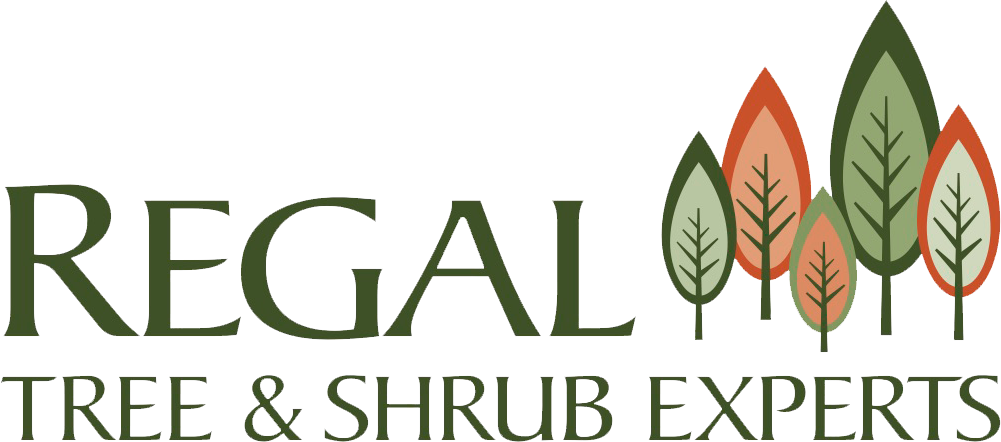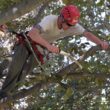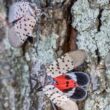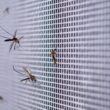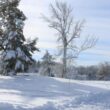Summer is a time of great growth for trees, but the trees in your yard may also be experiencing tremendous stress. Factors such as increased heat and the higher probability of drought can lead to trees struggling to survive. In our area of Massachusetts, we regularly see temperatures hot enough to cause summer tree stress.
Once the summer signs of stress in a tree are visible, it may be difficult to nurse the tree back to perfect health. If you have trees in your yard, you must take preventive measures to keep them healthy and unstressed. In this article, we will cover the best practices to avoid tree stress and provide a guide for determining if your tree is stressed.
Key Takeaways
- Increased heat and threats of drought can stress your trees in the summer.
- Stressed trees typically demonstrate symptoms of wilted leaves, flaking bark, secretions, or premature leaf drop.
- Younger trees are more prone to stress than established ones.
- Preventing stress may require proper irrigation, pruning, mulching, fertilizing, and pest inspections.
- An arborist can inspect your trees to determine their stress and how to fix them.
Stressors for Trees in the Summer
Trees are typically able to endure regular summer conditions. However, a combination of environmental factors can increase the risk of damage and summer stress to your trees.
Increased Pest Presence When the Weather is Warm
Most common pests that attack trees are active in the summer when the heat rises. Invasive pests such as the spongy moth (Lymantria dispar), emerald ash borer (Agrilus planipennis), and spotted lanternfly (Lycorma delicatula) are among the insects that can damage trees during the summer months.
Increased Heat in the Summer
Temperatures in our area during the summer generally remain around the 80s and occasionally reach 90°F or above. Prolonged periods of extreme heat will stress a tree, especially if combined with drought.
In general, trees are most comfortable and do the most growing when the temperature is between 70 and 85°F. However, photosynthesizing rates fall off when the temperature reaches 94°F.
In cities and urban areas, the temperature for trees can become even hotter due to heat radiating from sidewalks and roads. This increased heat will stress a tree and lead to limited growth.
Lack of Water and Potential Droughts in the Hot Season
Droughts in the summer can significantly stress a tree as it attempts to get the water it needs to survive. While our precipitation generally remains constant throughout the year, a drought in the summer is more devastating to a tree as it combines with the heat to stress the tree.
Increased Transmission of Some Diseases in the Summer
Many tree diseases tend to spread in the spring and summer. A tree fighting off disease in tandem with other environmental factors will decrease the tree’s health and contribute to additional stress.

These wilted leaves may be a symptom of summer tree stress.
Signs to Determine if Your Tree is Stressed
Trees have numerous ways to tell us when they aren’t feeling well and are under stress. If you notice any signs of distress in your trees, contact an arborist to examine them, determine what is causing the stress, and discuss how to treat it. Some classic signs of a tree dealing with stress include:
- Leaf wilting
- Scorched leaf edges
- No new growth
- Dead leaves
- Premature leaf drop
- Premature fruit drop in ornamental trees
- Secretions
- Flaking bark
Techniques for Preventing Excess Summer Tree Stress
Regarding tree care, an ounce of prevention is often worth a pound of cure, and prevention is vital to avoid long-term damage to your trees. Following these steps as the spring turns to summer can help you limit any potential issues with your trees during the growing season.
A certified arborist can assist you with preparing for the summer and taking care of your trees in drought, extreme weather, or pest attacks.

This diagram demonstrates the best places to water your tree during drought to ensure the roots all receive water.
Watering and Irrigation When Rainfall Isn’t Enough
Trees have varying needs, and some may need more water than others during periods of drought. When the temperature soars in the summer, a tree can lose up to 100 gallons of water in a single day. You’ll need to consult the forecast each week to determine the watering needs for your tree.
Generally, a tree will need about one inch of water each week during the growing season to maintain health and stimulate growth. If the forecast does not predict any rainfall for the week, we advise you to supplement your tree with water.
While some established trees may be able to survive without water for longer, newly planted trees desperately need additional water during periods with lower rainfall.
When watering a tree, you’ll want to avoid the temptation to point your hose directly at the base of the trunk and spray for a minute or so. Your primary tool should be drip irrigation, a soaker hose, or a garden hose with a low flow.
Your target should not be the tree’s base but at the edges of the canopy. Arborists refer to the edge of the canopy as the “drip line,” and you’ll want to concentrate your watering on this area. A tree does not have roots at its base, so watering at the drip line ensures that the entire root system has much-needed water.
Pruning Your Tree to Remove Dead Material and Increase Airflow
There are a few reasons for summer pruning that will help de-stress your tree. Some reasons you may opt for summer pruning include:
- Removing dead or diseased material: Dead branches need to be removed as soon as possible. Dead branches often attract pests that can damage your tree, and a diseased branch can further damage the rest of your tree if not removed.
- Improving airflow: A crowded crown will restrict airflow for your tree and limit its ability to photosynthesize, allow sunlight inside, and control its temperature. You should only trim 20 to 25 percent of the tree’s crown at a time, and you’ll want to be careful not to encourage growth.
If you plan to prune your tree in the summer, you should hire a professional who can handle the job and avoid making pruning mistakes that will increase the stress on your tree.
Proper Mulching to Improve Your Tree’s Health
Adding organic mulch around your trees is always recommended, and it has numerous benefits for the trees in your yard. The soil in your yard is very different from what trees find in the forest, and mulching helps create a more hospitable environment for your trees. Some of the benefits of mulching you’ll notice in the summer include:
- Conserving water and reducing the loss of moisture
- Keeping the soil cooler
- Reducing soil compaction
- Encouraging proper root growth
- Providing nutrients to the soil
Poor or improper mulching will increase a tree’s stress, so you should always maintain the proper techniques. Some practices to keep in mind include:
- Mulch in the spring when root growth begins
- Mulch to the drip line of the tree if possible
- Choose an organic mulch to enrich the soil
- Apply a layer of mulch between two and four inches
- Avoid putting mulch up to the trunk, as the root flare (part of the tree where the trunk widens as it enters the ground) should be visible
- Avoid over mulching
WARNING: Surrounding your tree in a “mulch volcano” where you pile up the mulch on the trunk is bad for the tree and will contribute to summertime stress.
Inspect For Pests Around Your Tree
With insect pests more active during the warm summer weather in Massachusetts, you must take preventive measures to avoid a pest outbreak on your property and decrease the stress on your trees during the summer.
Different trees and pests will present varied symptoms. You’ll want to know some of the common insect pests in our area and the signs of an infestation. Some typical signs of a pest problem with your trees include:
- Chewed foliage
- Holes in the bark
- Spots on leaves
- Stunted leaves
- Yellowing leaves
If you notice these signs, you must contact an arborist to schedule a pest inspection and create a plan to treat the problem.
Consider a Tree Growth Regulator
Tree growth regulators can help control your trees’ growth and resist some of the stressors of summer.
Tree growth regulators work to limit the synthesis of gibberellin, the hormone that allows a tree to expand its cells and increase the size of shoots. The regulator will slow the tree’s growth and leave it better able to withstand the elements of a hot summer. Some of the benefits of a tree growth regulator include:
- Conserving water
- Better transpiration (the process of water movement throughout a plant)
- Increased disease resistance
Our team at Regal Tree & Shrub Experts can assess your trees and give you an honest opinion on whether a tree growth regulator is suitable for your yard.
Correct Fertilization of Your Trees
Trees in your yard may have trouble accessing all the nutrients they usually would if they were in the forest. Fertilization can help a tree get the nutrients it needs in urban or suburban environments.
PRO TIP: Avoid over-fertilizing a tree, as this can lead to excess growth and further stress on the tree. Consult our Regal Tree & Shrub Experts team for help determining if your trees need fertilizers.
You may want to fertilize trees when you notice leaf problems, such as a small size or pale color. Young trees may need fertilizer to properly grow early in their lives.
In addition to fertilizing your trees, you may also want to consider using limestone. Massachusetts’s soils are acidic, and applying limestone will reduce the acidity in your soil. Test your soil every four years to understand what it needs for your plants to thrive.
Use Proper Planting Techniques When Adding Trees
While all our techniques have focused on protecting plants in your yard from stress, there are also steps you can take to limit any future trees from dealing with summer stressors. Planting a tree correctly will limit problems down the road. Some of our recommendations when planting a new tree include:
- Plant trees away from foot traffic to limit soil compaction
- Know the conditions of the soil and what hardiness zone you plan to plant in (Typically 7a or 6b in our area)
- Pick the right plant for the right place
- Dig a hole as deep as and three times as wide as the root ball
- Remove the burlap around the tree root
- Backfill the hole with the original soil
- Avoid packing the soil
If you plant your trees with the proper techniques, you will have healthier trees better able to withstand the stresses summer puts on them.
Saving a Stressed Tree May Require an Arborist
If you notice any signs of stress from your tree, it may be a sign that it’s too late to do anything to save the tree. As soon as you notice a problem with the tree, you will want to contact an ISA Certified Arborist to conduct an assessment.
Our team at Regal Tree & Shrub Experts will examine your tree and diagnose it based on our findings. We will recommend treatment options to save the tree or suggest removal if nothing can be done to bring it back to health.
Avoiding Stress in a Newly Planted Tree
Newly planted trees that have yet to establish deep root systems in your yard are more susceptible to stressors than trees that have been planted in the same spot for several years.
If you have a new tree on your property, you’ll want to follow many of these steps to protect it during its early years. Ensure your newly planted tree gets enough water, has properly fertilized soil, and has an appropriate amount of mulch around it. Consider staking the plant if summer storms threaten to uproot the tree.
The Team at Regal Tree & Shrub Experts Can Help With Summer Tree Care
Protecting your trees from summer tree stress can help them make it through the sometimes difficult season. Trees face numerous challenges in the Massachusetts summer, including increased heat, potential drought, pests, and diseases. Avoiding stress in your trees will limit any damage they suffer and keep them healthy year-round.
Our team at Regal Tree & Shrub Experts can help you prepare for the summer heat and ensure your trees avoid as much stress as possible. Call us at 774-719-2450 or request a quote online to learn more about how we can help your trees thrive no matter the season.
